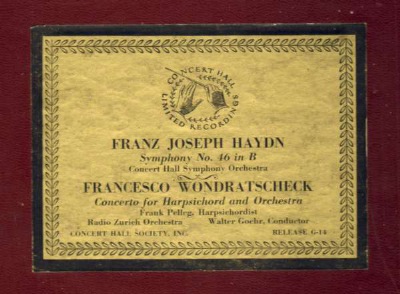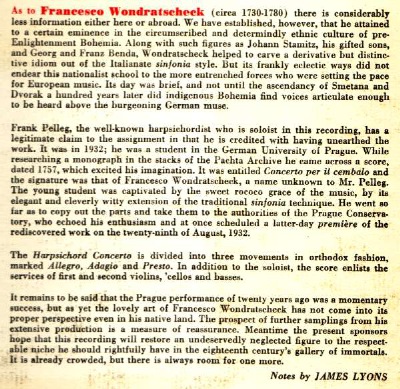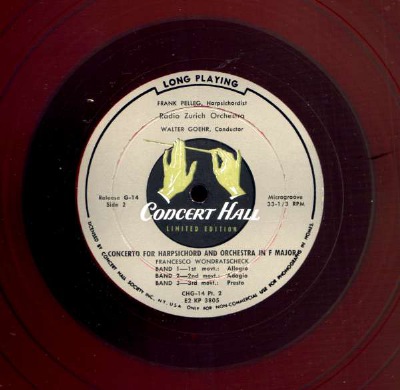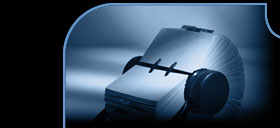 | 
Francesco Wondratscheck, Concerto pour clavecin et cordes en fa majeur, Frank Pelleg, Radio-Orchester Zürich, Walter Goehr, Concert Hall Release G-13
 Est-ce-que Francesco Wondratscheck a vraiment existé, ou bien est-ce-que ce nom a été inventé et que l'oeuvre a été en réalité composée dans un style ancien par Frank Pelleg et/ou Walter Goehr?? Est-ce-que Francesco Wondratscheck a vraiment existé, ou bien est-ce-que ce nom a été inventé et que l'oeuvre a été en réalité composée dans un style ancien par Frank Pelleg et/ou Walter Goehr??
Je ne peux pas répondre à cette question, étant donné que je ne trouve pas d'autres sources que celles se rapportant à cet enregistrement! Voici ce qu'a écrit James Lyons à l'époque sur le verso de la pochette du disque:
"[...] As to Francesco Wrondratscheck (circa 1730-1780) there is considerably less information either here or abroad. We have established, however, that he attained to a certain eminence in the circumscribed and determindly ethnic culture of pre-enlightenment Bohemia.
 Along with such figures as Johann Stamitz, his gifted sons,
and Georg and Franz Benda, Wondratscheck helped to carve a derivative
but distinctive idiom out of the Italianate sinfonia style. But its
frankly eclectic ways did not endear this nationalist school to the more
entrenched forces who were setting the pace for European music. Its day
was brief, and not until the ascendancy of Smetana and Dvorak a hundred
years later did indigenous Bohemia find voices articulate enough to be
heard above the burgeoning German muse. Along with such figures as Johann Stamitz, his gifted sons,
and Georg and Franz Benda, Wondratscheck helped to carve a derivative
but distinctive idiom out of the Italianate sinfonia style. But its
frankly eclectic ways did not endear this nationalist school to the more
entrenched forces who were setting the pace for European music. Its day
was brief, and not until the ascendancy of Smetana and Dvorak a hundred
years later did indigenous Bohemia find voices articulate enough to be
heard above the burgeoning German muse.
Frank
Pelleg, the well-known harpsichordist who is soloist in this recording,
has a legitimate claim to the assignment in that he is credited with
having unearthed the werk. It was in 1932; he was a student in the
German University of Prague. While researching a monograph in the stacks
of the Pachta Archive he came across a score, dated 1757, which excited
his imagination. It was entitled Concerto per il cembalo and the
signature was that of Francesco Wondratscheck, a name unknown to Mr.
Pelleg. The young student was captivated by the sweet rococo grace of
the music, by its elegant and cleverly witty extension of the
traditional sinfonia technique. He went so far as to copy out the parts
and take them to the authorities of the Prague Conservatory, who echoed
his enthusiasm and at once scheduled a latter-day première of the
rediscovered work on the twenty-ninth of August, 1932.
The
Harpsichord Concerto is divided into three movements in orthodox
fashion, marked Allegro, Adagio and Presto. In addition to the soloist,
the score enlists the services of first and second violins, cellos and
basses.
It remains to be said that the Prague
performance of twenty years ago was a momentary success, but as yet the
lovely art of Francesco Wondratscheck has not come into its proper
perspective even in his native land. The prospect of further samplings
front his extensive production is a measure of reassurance. Meantime the
present sponsors hope that this recording will restore an undeservedly
neglected figure to the respectable niche he should rightfully have in
the eighteenth century's gallery of immortals. It is already crowded,
but there is always room for one more. [...]" Notes by James Lyons, Concert Hall Release G-14
Si quelqu'un en sait plus, celà m'intéresserait beaucoup -> Vos remarques.
Frank
Pelleg est donc ici le soliste, il est accompagné par l'Orchestre de la
Radio de Zurich dirigé par Walter Goehr. La première parution a lieu
sur la 2e face d'un splendide vinyle rouge Concert Hall Release G-14
(tirage limité) vers 1952-1953, étant donné que la parution de ce disque
est annoncée dans le 2e supplément du WERM. Je n'ai pas pu trouver de
réédition, ni sur disque, ni sur CD.
Malgré un état
splendide de mon disque, la qualité de la prise de son n'est - en ce qui
concerne l'orchestre - hélas pas des meilleures, un son souvent
"pâteux". Le son du clavecin est par contre heureusement assez bien
enregistré.
Voici donc...
Francesco
Wondratscheck, Konzert für Cembalo und Orchester in F-Dur, Frank Pelleg,
Radio-Orchester Zürich, Walter Goehr, Concert Hall Release G-13 (1.
Allegro 05:47, 2. Adagio 05:37, 3. Presto 04:41)
que vous pouvez obtenir en...
______________________________CLIQUANT_ICI______________________________
 Concert Hall limited edition release G-14 CHG-14 Pt. 2 E2 KP 3805, E2KP-3805-1R CHCL-14-2 -> WAV -> léger DeClick avec ClickRepair, des réparations manuelles -> FLAC Concert Hall limited edition release G-14 CHG-14 Pt. 2 E2 KP 3805, E2KP-3805-1R CHCL-14-2 -> WAV -> léger DeClick avec ClickRepair, des réparations manuelles -> FLAC
3 fichiers FLAC, 2 fichiers CUE (*) et 1 fichier PDF dans 1 fichier ZIP
(*) 1 fichier CUE pour les fichiers décomprimés en WAV et 1 fichier CUE pour les fichiers comprimés FLAC, si votre logiciel peut utiliser directement les fichiers FLAC.
|  |

